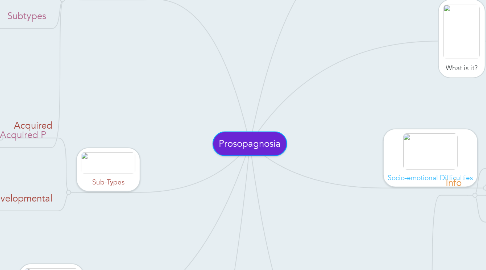
1. Sub-Types
1.1. Acquired
1.1.1. Adult Onset
1.1.2. Child Onset
1.2. Developmental
1.2.1. Congenital/ Hereditary
1.2.2. Concurrent Developmental Disorder e.g. Autism
1.2.3. Pure Developmental
2. Acquired Prosopagnosia
2.1. Details:
2.1.1. Immediate loss of face processing ability
2.1.2. Permanent damage
2.1.3. Use physical characteristics to recognise people
2.1.4. Very rare - <100 cases
2.2. Aetiology
2.2.1. Due to:
2.2.1.1. Brain Injury
2.2.1.2. Encephalitis
2.2.1.3. Neuroplasms
2.2.2. Damage to..
2.2.2.1. Right occipital temporal area
2.2.2.2. Sometimes FFA
2.2.2.3. General occipital lobe damage
2.3. Subtypes
2.3.1. Apperceptive =can't form intact faces + bad facial expression recognition
2.3.2. Associative = memory loss for faces
2.4. Deficits associated with Acquired P
2.4.1. Left Hemianopia
2.4.2. Achromatopsia
2.4.3. Topographic Disorientation
2.4.3.1. Vectorial Orientation Damage
2.4.3.2. Loss of Environmental Familiarity + Landmarks
2.4.4. Object Recognition
2.4.5. Poor Contract Sensitivity
3. Congenital/Developmental
3.1. Info
3.1.1. McConachie (76) = 1st to identify it
3.1.2. 2% of pop (higher than Autism)
3.1.3. Dunchaine (07) = genetic contribution?
3.2. Developmental
3.2.1. Many children have P absence of brain injury
3.2.2. Hasson and Behrmann
3.2.2.1. 1 smaller temporal lobe
3.2.2.2. 6 smaller right anterior FFA
4. Infantile Cateracts
4.1. Geldhart (02)
4.1.1. Birth Defect
4.1.2. 17 People
4.1.3. Operated on 3-6 months
4.1.4. Poor recognition in those who relied upon eye gaze direction + lip reading
4.1.5. Critical Period?
5. What is it?
5.1. Inability to recognise faces
5.2. Can see conceptual features e.g. eyes
5.3. Can't see differences in peoples faces
6. Socio-emotional Difficulties
6.1. Behavioural Difficulties
6.2. Lack of stranger danger
6.3. Differences between school and home
6.4. Few and distinctive friends
6.5. Trouble following plot lines
6.6. Lacks confidence
6.7. Separation Anxiety
6.8. Anxiety/Fear when meeting people
7. Challenges Facing Researchers
7.1. Need public awareness
7.2. Need professional awareness
7.3. Better diagnostic characteristics
7.4. Better intervention strategies
7.5. Explanation for underlying cause
8. Face Processing: Autism
8.1. Info
8.1.1. Socio-emotional difficulties in DP
8.1.2. Common in Autistic People
8.1.3. Intrinsically Linked vs. Very Separate?
8.2. Against
8.2.1. Dunchaine (10)
8.2.1.1. 2 DP Males
8.2.1.2. Not Autistics
8.2.1.2.1. Autistic-Spectrum Quotient Questionnaire
8.2.1.2.2. Autistic Diagnostic Observational Schedule
8.2.1.2.3. Animation Theory of Mind test
8.2.2. Barton (04)
8.2.2.1. 8/24 SDD = no problems with facial recognition
8.2.2.2. 16/24 = lower than controls, not as low as DP
8.3. Neural Underpinnings
8.3.1. Pelphery (02)
8.3.1.1. ASD Participants
8.3.1.2. Eye movement from peripherals to facial features
8.3.1.3. Avoid looking at Expressions
8.3.1.4. Less practiced
8.3.2. DeWitt (08)
8.3.2.1. Seen in children as young as 3
